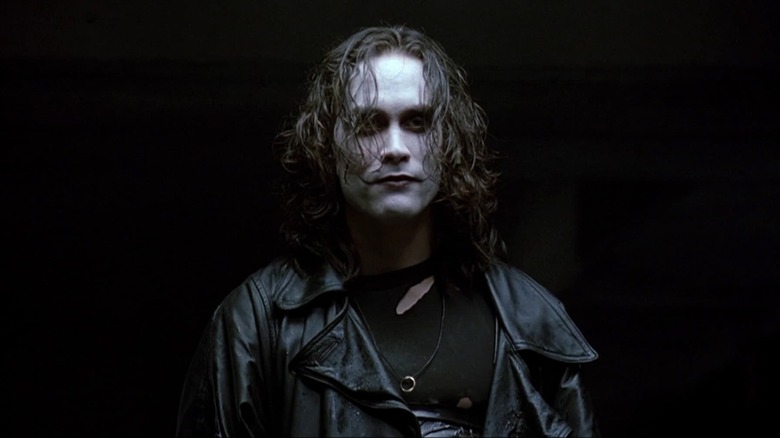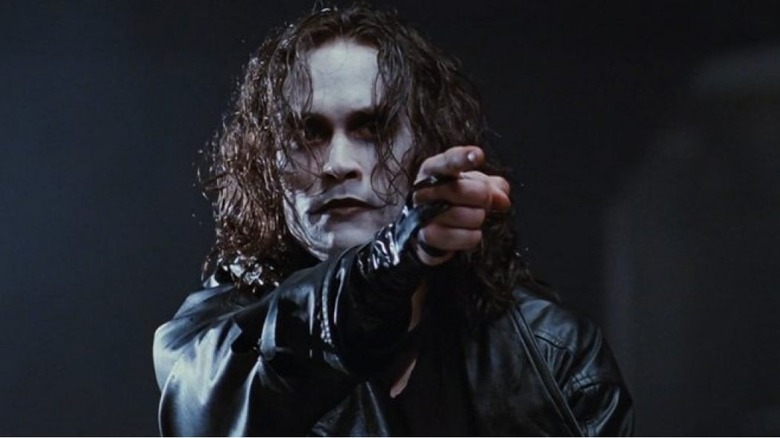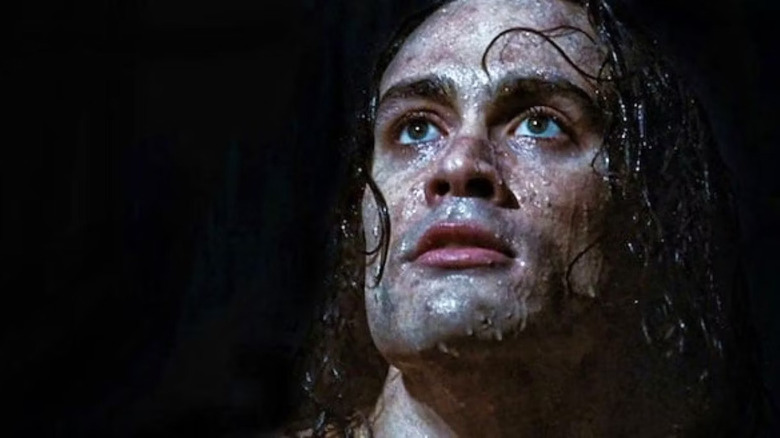The Crow Franchise Has A Tragic Legacy That Still Resonates To This Day
Alex Proyas' 1994 Gothic superhero-adjacent film "The Crow" — based in the 1989 comic book by James O'Barr — may not be the best film of the 1990s, but it might be the most 1990s film of the 1990s. Proyas' bleak, overdecorated Bauhaus aesthetic, paired with the film's self-pitying themes of violent, vengeful angst, speak incredibly loudly to the Gen-Xers who saw it as teens. "The Crow" gave voice to a certain generation's tendency to see the world as corrupt and untrustworthy, and it was only rising above death and destroying the evildoers that a bleak kind of catharsis might be achieved. "The Crow" is adolescent, yes, but important.
The plot of "The Crow" is dark and simple. In a dark, alternate version of Detroit, Eric Draven (Brandon Lee) is shot and killed while he watches his fiancée (Sofia Shinas) get brutally assaulted. A mystical crow, however, finds Eric's departed soul and reunites it with his body, bringing him back to life. Undead with nothing to lose, and now sporting black leather and pancake white face paint, Eric sets about finding and killing the men who committed these horrors against him.
Notoriously, Brandon Lee was shot and killed during production of "The Crow." During one of the final, climactic shootouts, an ill-maintained prop gun actually blasted out an unexpected projectile, striking Lee and killing him. It was a gigantic story at the time and deeply tragic, especially given how much promise the young Lee had already shown as an actor.
Many myths have since sprung up about Lee's shooting, and the record has needed to be cleared several times. We here at /Film will present the facts of the shooting and what actually went down.
What happened with Brandon Lee's death during The Crow?
All of the details of Lee's death are covered thoroughly in the Shudder documentary series "Cursed Films," which points out just what happened with the prop gun that caused it to become "loaded."
You see, when one sees an extreme close-up of a revolver, one can usually see that it's loaded with real bullets. In most cases, the bullets you see have been altered for safety, having been emptied of their gunpowder and outfitted with "dummy" bullets. The trigger can be squeezed, but a bullet will not fire. In the case of the prop gun on "The Crow," however, the prop bullet was "fired" into the chamber of the gun, and remained there for a few days without the prop masters noticing.
Later in production, the same gun was re-loaded with actual blanks, which have gunpowder but no projectiles. Sadly, when a blank cartridge was fired, it caused the prop bullet lodged in the barrel to dislodge and shoot into Brandon Lee. The dummy bullet was fired with the same power as an actual round, and it mortally wounded Lee when it struck him in the belly.
When Lee died, there was some discussion as to whether or not production should continue. Lee only had three days left of filming, and the producers wondered if it was in good taste to replace Lee with a stunt performer. They opted for the latter, with stuntman Chad Stahelski (director of the "John Wick" franchise) filming the remainder of Lee's scenes and visual effects being used to replace his face in certain shots.
To dispel the most popular rumor about the shooting, no, Lee's fatal wounding was not included in the final cut of the film.
The legacy of The Crow lives on
After the shooting, James O'Barr expressed nothing but regret for his creation. O'Barr invented "The Crow" as a therapy tool, using it to get over the very real death of his fiancée, Beverly. He thought that wallowing in his darkest revenge fantasies might provide some emotional freedom. Instead, it just left him in the shadows. Then, seeing that his creation caused more death rather than freeing him from it filled him with horror. It was only after years of consideration that O'Barr allowed "The Crow" to be adapted to film again.
No conversations about "The Crow," its many sequels, TV series adaptation, or tie-in video games can be discussed without the memory of Lee's death hovering over it. The actual on-set tragedy reflects the horror of the film's subject matter, the horror the audiences felt about the world, and the general sadness "The Crow" represents. Death, in this case, wasn't a glorified or romantic phenomenon made poetic by Goth artistry. It was brutal, sudden, and ugly. Lee, it should be noted, was engaged to Eliza Hutton, and the pair were planning to marry as soon as production on "The Crow" wrapped.
Lee, who was the son of martial arts legend Bruce Lee, hadn't appeared in many films by 1994. He'd starred in "Showdown in Little Tokyo," the B-movie "Laser Mission," and played the lead in the actioner "Rapid Fire." He was a rising star, and many felt he would easily live up to the legacy of his father. Had Lee lived, he would be 59 years old today, and it's a shame we never got to see his career take off.


